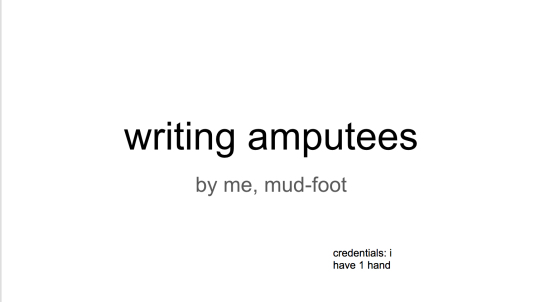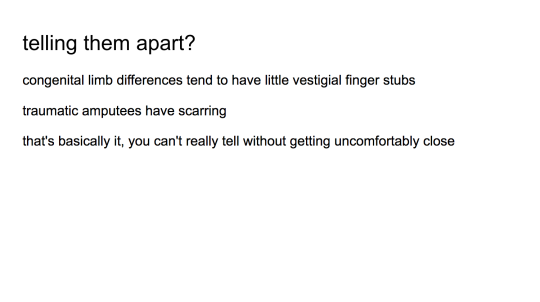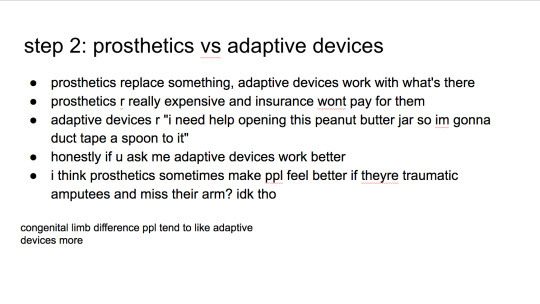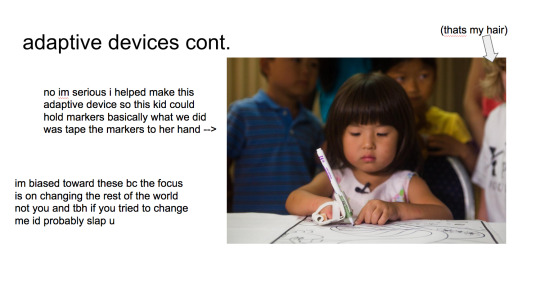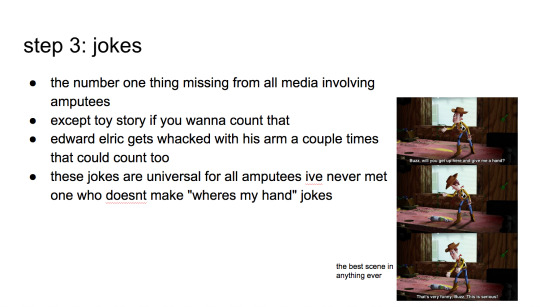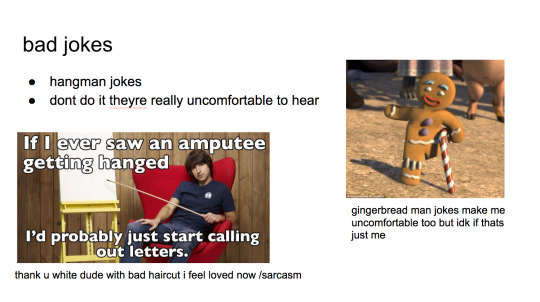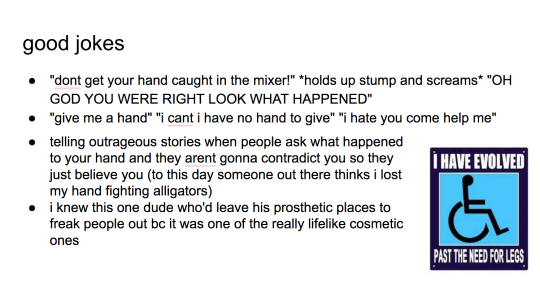OC-pudden is an open network for Original Characters of the Naruto roleplay community. Here, we aim to provide you with a positive space to look for other muns/muses who have a void you can fill with your own muse, giving each other an opportunity to generate creativity and flesh out your characters while filling the gaps in your individual canons. Who knows; you might find friendships among the muns, too! If you’re just looking around for characters your muse can approach and build a relationship with, that’s cool too!
Don't wanna be here? Send us removal request.
Text
writers:
break up your paragraphs. big paragraphs are scary, your readers will get scared
fuuuuck epithets. “the other man got up” “the taller woman sat down” “the blonde walked away” nahhh. call them by their names or rework the sentence. you can do so much better than this (exception: if the reader doesn’t know the character(s) you’re referring to yet, it’s a-okay to refer to them by an identifying trait)
blunette is not a thing
new speaker, new paragraph. please.
“said” is such a great word. use it. make sweet love to it. but don’t kill it
use “said” more than you use synonyms for it. that way the use of synonyms gets more exciting. getting a sudden description of how a character is saying something (screaming, mumbling, sighing) is more interesting that way.
if your summary says “I suck at summaries” or “story better than summary” you’re turning off the reader, my dude. your summary is supposed to be your hook. you gotta own it, just like you’re gonna own the story they’re about to read
follow long sentences w short ones and short ones w long ones. same goes for paragraphs
your writing is always better than you think it is. you just think it’s bad because the story’s always gonna be predicable to the one who’s writing it
i love u guys keep on trucking
226K notes
·
View notes
Photo

So, so many works I’ve read could be vastly improved with tightening and shaving of superfluous words. Wordiness is an easy stumbling block, as we’re used to how we talk. We’re used to how others (long ago) wrote. But times change, my friend, and so do expectations of the writer. We don’t get paid by the word in fiction. So show your smarts and say as much as you can with as much power as you can in as few words as possible.
Here are a few things you can cut without reserve to help shorten your story right now. And as you catch yourself using these words in your next draft, hit that backspace before you finish the sentence! It’s okay if you already have. You can go delete them now. No one will ever know.
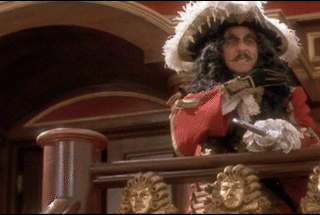
Moment/Second/Minute
It’s so tempting. I am guilty of using this word like fertilizer in my first drafts. But most of the time, these words aren’t needed at all. They add nothing.
He sat down for a moment, sipping his coffee. vs. He sat down and sipped at his coffee.
But he only did it for a moment, you say!
He sat down for a moment, sipping his coffee. When the door opened a second later, he shot to his feet. vs. He sat down and sipped his coffee. The door opened, and before he could swallow his first sip, he shot to his feet.
I know, this is about making your writing more concise and my “right” example has more words than the first example. But what’s the difference? The words used in the second sentence are more tangible. They give a visual that “a second later” and “for a moment” don’t. And you could leave that part out, of course, if you’re really going for trimming word count. It doesn’t paint quite the same image, but “The door opened and he shot to his feet.” is a perfectly good sentence.
Suddenly/All of a sudden
You’ve heard this one, before, surely. These words are used…when? When you’re trying to portray suddenness. Surprise, perhaps. So why are you adding in extra words to slow down the pace?
She flipped on the TV and reclined in her chair. All of sudden, the TV flashed a bright light and the power went out. vs. She flipped on the TV and reclined in her chair. The TV flashed once before the lights went dark. The power was out.
That sense of immediacy is felt when stuff just happens. So let it happen. If it’s rhythm you’re worried about, then find more useful words to create the rhythm. Notice that I didn’t just cut “All of a sudden” out of the sentence and leave it. I reworded it a bit to make it stronger.
Finally
It can be a useful word, but more often than not, it’s just taking up space.
Really/Very
Just…delete them.
To alter a Mark Twain quote:
“Substitute ’[fucking]’ every time you’re inclined to write ‘very;’ your editor will delete it and the writing will be just as it should be.”
But seriously, if you’re saying, “She was breathing very hard.” You could just cut the “very” and say, “She was breathing hard.” Or, even better, “She was panting.” Or, EVEN BETTER: “She panted.”
Himself/herself/myself/themselves
Reflexive nouns have a specific purpose, though they can still often be avoided. They fall into the category of “use only when it’s confusing otherwise.”
Correct: He looked at himself in the mirror. Better: He looked in the mirror.
Incorrect: She gave them to Andrew and myself before leaving. Correct: She gave them to Andrew and me before leaving.
Technically correct I guess: I haven’t eaten lunch myself. (Intensive pronoun; aka waste of words) Better: I haven’t eaten lunch.
Intensive pronouns add emphasis, but that emphasis is negligible and often negated by the power of tightening your narrative.
That
You can likely cut 60% of your “that"s and your story will be unaffected. Sometimes, you do need to add a "that” here and there for clarification, but not always. And sometimes it’s just plain incorrect.
The jacket was the coolest one that he’d ever owned. vs. The jacket was the coolest one he’d ever owned.
In other cases, you might do well to substitute “that” with “which.” Though, if you’re doing this, make sure you do it properly. That change can often alter the meaning of your sentence. That can be for the better, though.
The vandalism that read “Bad Wolf” made Rose nervous. vs. The vandalism, which read “Bad Wolf,” made Rose nervous.
Do you see the difference? In the first sentence, the words are what make Rose nervous. In the second, the vandalism itself makes Rose nervous, and it happens to say “Bad Wolf.” In this case, if you’ve watched Doctor Who, then you know the first example is the correct one.
So when you’re sharing details using “that” or “which,” contemplate how important they are to meaning of the sentence to determine which type of clause you need to use.
Then
Or worse, “And then.”
It makes your writing sound a bit juvenile. Either cut it entirely, or substitute “and.”
She jumped into the pool, then hit her head on the bottom. vs. She jumped into the pool and hit her head on the bottom.
And then, after all that time, she fell asleep. vs. After all that time, she fell asleep.
Even
Sometime “even” can help emphasize a situation or behavior, but when it’s used in narrative improperly, it sounds childish and silly.
He couldn’t even breathe. vs. He couldn’t breathe.
Even with the new hair gel, his hair was terrible. (This one is fine, though you could still cut that “even” if you really wanted to…)
Just
Just…Delete it.
Breathe/breath/exhale/inhale/sigh/nod/shrug
Another one I’m so guilty of. In my first drafts, I tend to talk about how a character is breathing, or when they’re sighing like nobody’s business. I know a lot of writers who are guilty of this, too. It’s a great tool to use scarcely. In intense moments, you can let your character take a final deep breath to calm themselves. When a character almost drowns, those first few sweet breaths are important. But you readers know that people breath all the time. And just because you need a beat in your dialogue doesn’t mean you need to remind your reader that the character is still breathing or moving.
Rather/quite/somewhat
She was rather tall. She was tall. He was quite idiotic. He was idiotic. They were somewhat snazzy. They were snazzy. Why do you need those words? Kill 'em.
Start/begin
This is a great example of fluff.
She started to run toward the shop. vs. She ran toward the shop.
He began scolding them for their performance. vs. He scolded them for their performance.
There are obviously uses for this word, like anything. He started the car. Begin your tests! But when you’re using it to slow the action and the pace of your narrative, then consider heavily if you need it. You probably don’t.
In order to/in an attempt to
Phrases that add unneeded complications, cumbersome wording…kill 'em!
She bit down in an attempt to stop herself from screaming. vs. She bit down to stop herself from screaming.
Was able to
He was able to call. vs. He could call. OR He called.
This is one that isn’t inherently bad, but it can easily be overused and cutting it will help simplify your narrative.
Due to
Ugh. Are you trying to sound proper and stuffy? Because that’s a reason, I guess, to use this phrase…and yet it sounds like doodoo. (Yes. I’m an adult.) Rephrase. Use “Because of” or just avoid the need altogether.
We stopped due to traffic. vs. We stopped because of traffic. OR (Strength of narrative!) We stopped mid-highway. The parked cars went on beyond the curve of the road, out of sight.
Visibly/obviously/apparently/audibly
These are a sign of telling in your narrative when you should probably be showing.
She was visibly shaking. –> She shivered, hugging her upper arms. He was obviously tired. –> He yawned and tripped on his own feet as he crossed the room. They were apparently angry. –> They stomped and shouted, demanding attention. She screamed audibly. (Really?) –> She screamed.
Don’t tell your readers what emotion a character is feeling. Instead, give a few clues that they can see/hear/feel the emotion too.
While
This word has lots of legitimate uses. However, if you’re using it poorly, then your narrative reads like an Early Reader’s book, and you (unless that’s what you’re writing) probably don’t want that.
“Get it together,” he said while flipping them off. vs. “Get it together,” he said, flipping them off.
Turned
One of the classics. So overused, my friends. It’s needed on occasion, but not nearly as often as we use it. Just cut it out.
They turned toward her as they spoke. vs. They gave her their full attention as they spoke. OR They looked into her eyes. OR (Nothing. Readers don’t have to be updated on every little movement.)
Saw/looked/regarded
UGH. Regarded:Looked::Mentioned:Said
And, like “said,” many, many instances of these words can be nixed.
She saw them run for the hills. vs. They ran for the hills.
This can be tricky, I know, when you’re writing in limited-third or first POV. It’s tempting to put every action directly through your POV character’s filter. But resist that temptation! There are times when it’s appropriate, occasionally, but it can be overdone so easily.
I looked at her and said, “Please.” vs. I said,“ Please.” OR. I took her hand. “Please.”
This example sides with the breathing and the turning. It’s often an unneeded update on the tiny movements of the characters. And, again, sometimes you need that beat or that little detail in an intense moment, but not often.
Said/replied/stated/spoke/mentioned/asked/commented/yelled/cried/shouted
I’m not here to tell you to cut all your dialogue tags (please don’t). I’m also going to the last person who insists you get rid of “said.” In fact, I’m in the “said is invisible” party of writing nerds and I think, if you’re going to use a standard tag, it should be “said” 90% of the time.
But aside from that, using as few dialogue tags as possible is a good thing. I’ll do a full post on this soon, but for now, be aware of how often you rely on these words in your dialogue and do your best not to overuse them. Use surrounding action and context to take some of the reliance off of these words.
To-Be in all its conjugated forms
If you’re using any of this list:
am, is, are, was, were, be, being, had been
Then check yo'self. Some tenses call for an auxiliary verb. Some types of sentence do, too, not doubt about it. But many don’t, and cutting to-be verbs when you can will help tighten your writing.
We were going to the store. vs. We went to the store.
Sounds were echoing through the chamber. vs. Sounds echoed through the chamber.
To-be verbs can also be an indicator of passive voice, though they aren’t always.
He was hit by the ball. vs. The ball hit him.
Last but not least, check all of your adverbs.
Chances are, if you’re using an adverb, you could be using a single strong verb instead and giving each sentence more punch.
He ran quickly. –> He sprinted. I hit him hard. –> I socked him. She spoke quietly. –> She whispered. They ran into each other fast. –> They crashed.
So what am I supposed to do about this?
Take it to heart. Try not to let these words take over your brain as you write. Once your manuscript is finished, try this method:
Use Find and Replace. Replace any and all of the aforementioned words in ALL-CAPS. Now, if you’ve paid attention to my advice in using emphasis, then those all-caps will really stick out as you’re reading over your work and you can decide at each instance whether your usage is appropriate, or if it needs to be rewritten. As I did to this very old draft of mine from my first NaNoWriMo (in which I used every single word on this list, I’m sure).

When I used this method with my most recent WIP, I was able to cut my word count from 105k to 93k without cutting any content whatsoever. It takes a lot of work and it’s pretty tedious but the results are amazing!

It wouldn’t be the English language without exceptions, would it?
Now, there is actually an important time for intentionally using any or all of the words on this list. You know when that is?
When it fits the character’s voice. - More on this in my next post!
24K notes
·
View notes
Text
cropping icons quick & easy for windows users.
this tutorial isn’t just like, a step-by-step how to work it but some advice on how to work it well. the tips & tricks are gonna make your life easy, even easier than this program will make it.
i don’t know of a mac alternative, but if i ever find one i’ll be sure to link it!
( right click + open in new tab this link to read the tutorial outside of my theme & on a basic page with pictures / text undistorted. )
1. Download PickPic. obviously, pick the free option. it has all we need. if you want a brief overview of the program, go here!
Keep reading
65 notes
·
View notes
Text
different headcanon questions!!
1. What are three Netflix shows that they’ve rated five stars? 2. Where do they prefer to read? On the sofa, in bed, at a table, on the porch, in a cafe? 3. Do they like to play games? What kind of games: video, card, board? What are some of their favorites? 4. What’s their food weakness? What food can they never turn down? 5. Do they prefer movies or TV shows? Why? 6. What holiday is their favorite? Which is their least favorite? 7. What’s their diet like? Are they vegetarian, vegan? Do they have any food allergies that make them have a special diet? 8. What sort of toys did they play with as a child? 9. How often do they go grocery shopping? Do they tend to do one large trip, or smaller ones throughout the week? 10. Do they eat breakfast? What’s a typical breakfast look like for them? 11. Do they like going to museums? What type of museums do they like to go to? Art, science, historical; interactive, quiet, a mix? 12. How do they organize their books? Alphabetical by author, by title? By size, color, date published? Is there any rhyme or reason? 13. Have they ever been do Disney World/Land, or any other amusement park? What do they prefer to do at them: go on the rides, play the games, eat the food? 14. How do they eat their popcorn? What do they put on it? 15. When do they pay their bills? As soon as the bill comes in? At the last moment? Or are most of their bills automatically taken out of their account? 16. What time do they normally go to bed? How many hours of sleep do they usually need to function in the morning? 17. Do they have cable, or do they rely mostly on Netflix, Hulu, and other streaming services? 18. What is their preferred weather? What would be a perfect weather day? 19. Are they more of a snacker throughout the day, or they eat three meals and call it a day? 20. Have they ever had an imaginary friend? 21. What were they a part of in high school/college, if they went? Were they a part of any clubs, did they play any sports? What clique would they have been considered a part of? 22. Do they have a favorite restaurant? How often do they go to it, and what’s their usual order? 23. How do they prefer to watch movies? In the theater, on a streaming site, from an owned DVD/digital download, rented from somewhere? 24. Do they watch any sports? What are they a fan of, and what teams do they root for? Do they watch the games/matches on TV or do they try to be there for some in person? Do they just catch the highlights on their phone later on? 25. What do they prefer to do in the summertime? Do they like going to the beach, do they prefer camping, staying in the city? Do they like to stay indoors and away from the heat?
4K notes
·
View notes
Text
Stop using the word "Walk". We don't want that word to die together with "Said".
Here are a few words you can replace walk with.
AMBLE: WALK EASILY AND/OR AIMLESSLY
BOUNCE: WALK ENERGETICALLY
CAREEN: PITCH DANGEROUSLY TO ONE SIDE WHILE WALKING OR RUNNING
CLUMP: WALK HEAVILY AND/OR CLUMSILY
FALTER: WALK UNSTEADILY
FLOUNDER: WALK WITH GREAT DIFFICULTY
FOOT IT: (SLANG) DEPART OR SET OFF BY WALKING
FOOTSLOG: WALK HEAVILY AND FIRMLY, AS WHEN WEARY, OR THROUGH MUD
GIMP: LIMP; HOBBLE
HIKE: TAKE A LONG WALK, ESPECIALLY IN A PARK OR A WILDERNESS AREA
HOBBLE: WALK UNSTEADILY OR WITH DIFFICULTY; SEE ALSO LIMP
HOOF IT: (SLANG) WALK; SEE FOOT IT
LEG IT: (SLANG) SEE FOOT IT
LIMP: WALK UNSTEADILY BECAUSE OF INJURY, ESPECIALLY FAVORING ONE LEG; SEE ALSO FALTER
LUMBER: WALK SLOWLY AND HEAVILY
LURCH: WALK SLOWLY BUT WITH SUDDEN MOVEMENTS, OR FURTIVELY
MARCH: WALK RHYTHMICALLY ALONE OR IN A GROUP, ESPECIALLY ACCORDING TO A SPECIFIED PROCEDURE
MEANDER: WALK OR MOVE AIMLESSLY AND IDLY WITHOUT FIXED DIRECTION
MINCE: WALK DELICATELY
MOSEY: SEE AMBLE; ALSO, USED COLLOQUIALLY IN THE PHRASE “MOSEY ALONG”
NIP: WALK BRISKLY OR LIGHTLY; ALSO USED COLLOQUIALLY IN THE PHRASE “NIP (ON) OVER” TO REFER TO A BRIEF WALK TO A CERTAIN DESTINATION, AS IF ON AN ERRAND
PACE: WALK PRECISELY TO MARK OFF A DISTANCE, OR WALK INTENTLY OR NERVOUSLY, ESPECIALLY BACK AND FORTH
PAD: WALK WITH STEADY STEPS MAKING A SOFT DULL SOUND
PARADE: WALK OSTENTATIOUSLY, AS IF TO SHOW OFF
PERAMBULATE: SEE STROLL; TRAVEL ON FOOT, OR WALK TO INSPECT OR MEASURE A BOUNDARY
PEREGRINATE: WALK, ESPECIALLY TO TRAVEL
PLOD: WALK SLOWLY AND HEAVILY, AS IF RELUCTANT OR WEARY
POUND: WALK OR GO WITH HEAVY STEPS; MOVE ALONG WITH FORCE OR VIGOR; SEE LUMBER
POWER WALK: WALK BRISKLY FOR FITNESS
PRANCE: WALK JOYFULLY, AS IF DANCING OR SKIPPING
PROMENADE: GO ON A LEISURELY WALK, ESPECIALLY IN A PUBLIC PLACE AS A SOCIAL ACTIVITY; SEEPARADE
PROWL: WALK NOISELESSLY AND CAREFULLY IN A PREDATORY MANNER
PUSSYFOOT: WALK STEALTHILY OR WARILY
RAMBLE: WALK OR TRAVEL AIMLESSLY
ROAM: GO WITHOUT FIXED DIRECTION AND WITHOUT ANY PARTICULAR DESTINATION, OFTEN FOR PLEASURE; SEE RAMBLE
ROVE: TRAVEL CONSTANTLY OVER A RELATIVELY LENGTHY TIME PERIOD WITHOUT A FIXED DESTINATION; WANDER
SASHAY: GLIDE, MOVE, OR PROCEED EASILY OR NONCHALANTLY; SEE PARADE
SAUNTER: WALK ABOUT EASILY
SCUFF: WALK WITHOUT LIFTING ONE’S FEET
SHAMBLE: WALK OR GO AWKWARDLY; SHUFFLE; SEE SCUFF
SHUFFLE: WALK WITHOUT LIFTING THE FEET OR WITH CLUMSY STEPS AND A SHAMBLING GAIT; SEESCUFF
SKULK: MOVE IN A STEALTHY OR FURTIVE MANNER
SOMNAMBULATE: WALK IN ONE’S SLEEP
STAGGER: WALK UNSTEADILY
STALK: WALK STEALTHILY, AS IN PURSUIT
STEP: WALK, OR PLACE ONE’S FOOT OR FEET IN A NEW POSITION
STOMP: WALK HEAVILY, AS IF IN ANGER
STRIDE: WALK PURPOSEFULLY, WITH LONG STEPS
STROLL: WALK IN A LEISURELY WAY; SEE SAUNTER
STRUT: WALK WITH A STIFF, ERECT, AND APPARENTLY ARROGANT OR CONCEITED GAIT; SEE PARADE
STUMBLE: WALK CLUMSILY OR UNSTEADILY, OR TRIP
STUMP: WALK HEAVILY, AS WITH A LIMP; SEE LUMBER
SWAGGER: WALK WITH AGGRESSIVE SELF-CONFIDENCE
TIPTOE: WALK CAREFULLY ON THE TOES OR ON THE BALLS OF THE FOOT, AS IF IN STEALTH
TODDLE: MOVE WITH SHORT, UNSTEADY STEPS, AS A YOUNG CHILD; SEE SAUNTER AND STAGGER
TOTTER: WALK OR GO WITH FALTERING STEPS, AS IF FROM EXTREME WEAKNESS; SEE STAGGER(ALSO, SWAY OR BECOME UNSTABLE)
TRAIPSE: WALK LIGHTLY AND/OR AIMLESSLY
TRAMP: WALK HEAVILY OR NOISILY; SEE LUMBER AND HIKE
TRAMPLE: WALK SO AS TO CRUSH SOMETHING UNDERFOOT
TRAVERSE: WALK ACROSS OR OVER A DISTANCE
TREAD: WALK SLOWLY AND STEADILY
TRIP: WALK LIGHTLY; SEE ALSO STUMBLE
TROMP: TREAD HEAVILY, ESPECIALLY TO CRUSH UNDERFOOT; SEE LUMBER
TROOP: WALK IN UNISON, OR COLLECTIVELY
TROT: PROCEED AT A PACE FASTER THAN A WALK; SEE NIP
TRUDGE: WALK SLOWLY AND WITH HEAVY STEPS, TYPICALLY BECAUSE OF EXHAUSTION OR HARSH CONDITIONS; SEE PLOD
WADDLE: WALK CLUMSILY OR AS IF BURDENED, SWINGING THE BODY
WADE: WALK THROUGH WATER OR WITH DIFFICULTY, AS IF IMPEDED
WANDER: TO MOVE FROM PLACE TO PLACE WITHOUT A FIXED ROUTE; SEE RAMBLE
RESOURCES: (X) (X) (X) (X) (X)
30K notes
·
View notes
Text
Creating Likeable Characters
Sometimes it’s difficult to make your characters likeable as they are tested and are pushed to further and further lengths. Sometimes they have to make hard decisions, and sometimes the pressure gets to them and they mess up, hurt another character or an innocent bystander. How can you keep them likeable throughout the whole plotline?
- Keep their motivations pure. It almost always comes back to the heart – if their heart is pure, and that’s established early-on, the audience is more likely to root for them.
- Give them flaws – make them human. Not every character has to have some huge problem, like an addiction or a traumatic past or a disability – if your entire cast does, it’s no problem, but it’s not necessary. But every character has to have some flaw(s), whether it’s cheating at card games because he can’t stand to lose or being too-closed minded or closing off when she gets too emotional. If your character doesn’t have a flaw, they start to come off as too perfect, too angelic, pretentious.
- Give them permission to mess up. This ties in with flaws – if your character is inclined to make a bad decision at any point in the plot, don’t steer him away from it because “oh no he’s my protagonist and he must be Good and Whole and Pure and All-Knowing”. Let him walk into that ambush despite the sick feeling in his stomach and get half his army killed; let her rush into a confrontation with a bully and get into a fight with another girl who has a switchblade. Let your characters mess up – it shows that they’re human.
- But if your character messes up, let them own up to it eventually. The general who killed half his army by ignoring the unease in the back of his mind might cry over their makeshift graves long after the rest of the platoon is asleep; the girl sitting in the infirmary might feel remorse for knocking her opponent’s block off. Or your characters might argue and might be stubborn and might not apologize for weeks. But let them apologize eventually. This goes back to the heart, and what the character knows is right.
- Relationships with other characters are vital. That’s not to say a loner character can’t be likeable – but the audience’s perception of a loner character is determined by the thoughts/words of other characters. Characters all color each other and define parts of each other, just like people do to each other in real life. If your character is a jerk to other characters and other characters don’t like him (especially if the characters who dislike him are likeable), the audience won’t like him either. The character’s image depends not just on himself, but on his supporting cast.
Hope this helps! - @authors-haven
7K notes
·
View notes
Text
Character flaws
- Self-image: arrogant // having low self-esteem. The subtleties: the character getting him/herself into trouble because (s)he thinks (s)he can do more than (s)he actually can // a lack of confidence, which can be annoying to other characters & can possibly be dangerous, if it surfaces at a crucial moment The extremes: narcissism or a god complex // self-destruction (either conscious or unconscious)
- Temperament: uncontrollable // so controlled the character goes numb. The subtleties: irritable temperament, which causes conflict between characters // indifference that can be hurtful to other characters, which also causes conflict The extremes: verbal or physical violence (possibly homicide) // being cold, calculating and ruthless
- Opinions: strong // weak. (Although weak opinions or beliefs make for flawed characters, strong opinions on their own are not necessarily flaws – it depends on what the character believes so strongly, and if they believe so strongly they are no longer open-minded.) The subtleties: making enemies who have different beliefs than you // being seen as kiss-ass or wishy-washy The extremes: radicalism or zealotry // untrustworthiness
- Loyalty: loyal // disloyal. (Again, loyalty is not necessarily a flaw – as long as it’s in moderation.) The subtleties: annoying heroics // hesitation to help the protagonist(s), which, if the character in questions holds important questions/materials, can be problematic The extremes: zealotry or being foolishly loyal (unnecessarily leading self/others to danger or destruction due to loyalty – particularly pointless if it’s only to prove a point, rather than a practical reason) // untrustworthiness
Please, feel free to reblog with your thoughts/add-ons!
4K notes
·
View notes
Note
Hey, do you know any resources for writing dialogue? I struggle giving my muse their own voice, they all end up talking similarly.
i struggle with the same thing , you’re def not alone with that one so i don’t have any of my own tips but these are some articles that i’ve found !! lemme know if they were useful to you at all :)
Exercises to Improve Dialogue
All Your Characters Talk The Same — And They’re Not A Hivemind!
Talking about your character: Voice
5 Tips for Establishing Character Voices
Defining Character Voice
How to Write Characters Who Don’t Sound Like You
5 Steps for Creating Original Character Voices

578 notes
·
View notes
Photo
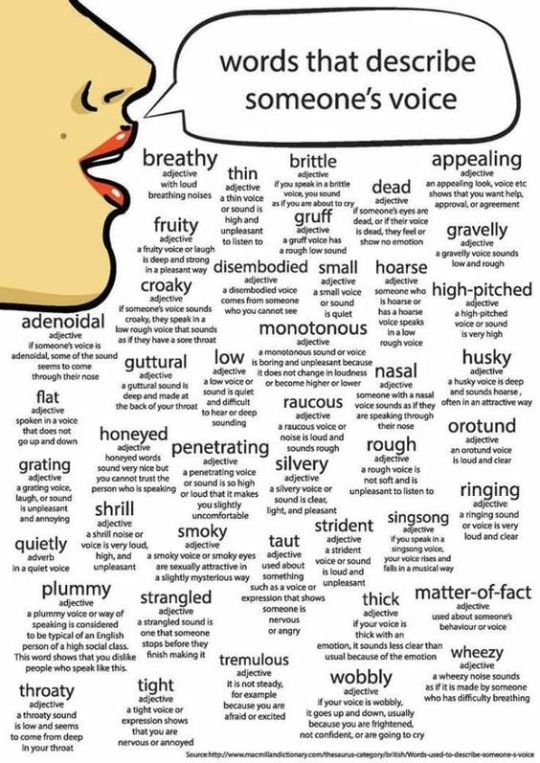
Words that describe someone`s voice. Very helpful!
1K notes
·
View notes
Text
Ambient sounds for writers
Find the right place to write your novel…
Nature
Arctic ocean
Blizzard in village
Blizzard in pine forest
Blizzard from cave
Blizzard in road
Beach
Cave
Ocean storm
Ocean rocks with rain
River campfire
Forest in the morning
Forest at night
Forest creek
Rainforest creek
Rain on roof window
Rain on tarp tent
Rain on metal roof
Rain on window
Rain on pool
Rain on car at night
Seaside storm
Swamp at night
Sandstorm
Thunderstorm
Underwater
Wasteland
Winter creek
Winter wind
Winter wind in forest
Howling wind
Places
Barn with rain
Coffee shop
Restaurant with customers
Restaurant with few customers
Factory
Highway
Garden
Garden with pond and waterfall
Fireplace in log living room
Office
Call center
Street market
Study room from victorian house with rain
Trailer with rain
Tent with rain
Jacuzzi with rain
Temple
Temple in afternoon
Server room
Fishing dock
Windmill
War
Fictional places
Chloe’s room (Life is Strange)
Blackwell dorm (Life is Strange)
Two Whales Diner (Life is Strange)
Star Wars apartment (Star Wars)
Star Wars penthouse (Star Wars)
Tatooine (Star Wars)
Coruscant with rain (Star Wars)
Yoda’s hut with rain ( Star Wars)
Luke’s home (Star Wars)
Death Star hangar (Star wars)
Blade Runner city (Blade Runner)
Azkaban prison (Harry Potter)
Hogwarts library with rain (Harry Potter)
Ravenclaw common room (Harry Potter)
Hufflepuff common room (Harry Potter)
Slytherin common room (Harry Potter)
Gryffindor common room (Harry Potter)
Hagrid’s hut (Harry Potter)
Hobbit-hole house (The Hobbit)
Diamond City (Fallout 4)
Cloud City beach (Bioshock)
Founding Fathers Garden (Bioshock)
Things
Dishwasher
Washing machine
Fireplace
Transportation
Boat engine room
Cruising boat
Train ride
Train ride in the rain
Train station
Plane trip
Private jet cabin
Airplane cabin
Airport lobby
First class jet
Sailboat
Submarine
Historical
Fireplace in medieval tavern
Medieval town
Medieval docks
Medieval city
Pirate ship in tropical port
Ship on rough sea
Ship cabin
Ship sleeping quarter
Titanic first class dining room
Old west saloon
Sci-fi
Spaceship bedroom
Space station
Cyberpunk tearoom
Cyberpunk street with rain
Futuristic server room
Futuristic apartment with typing
Futuristic rooftop garden
Steampunk balcony rain
Post-apocalyptic
Harbor with rain
City with rain
City ruins turned swamp
Rusty sewers
Train station
Lighthouse
Horror
Haunted mansion
Haunted road to tavern
Halloween
Stormy night
Asylum
Creepy forest
Cornfield
World
New York
Paris
Paris bistro
Tokyo street
Chinese hotel lobby
Asian street at nightfall
Asian night market
Cantonese restaurant
Coffee shop in Japan
Coffee shop in Paris
Coffee shop in Korea
British library
Trips, rides and walkings
Trondheim - Bodø
Amsterdam - Brussels
Glasgow - Edinburgh
Oxford - Marylebone
Seoul - Busan
Gangneung - Yeongju
Hiroshima
Tokyo metro
Osaka - Kyoto
Osaka - Kobe
London
São Paulo
Seoul
Tokyo
Bangkok
Ho Chi Minh (Saigon)
Alps
New York
Hong Kong
Taipei
290K notes
·
View notes
Text
Writing Tip: Don’t Be Afraid of Mixing Dialogue and Action
So I’ve been reading a lot of amateur writing lately, and I’ve noticed what seems to be a common problem: dialogue.
Tell me if this looks familiar. You start writing a conversation, only to look down and realize it reads like:
“I’m talking now,” he said.
“Yes, I noticed,” she said.
“I have nothing much to add to this conversation,” the third person said.
And it grates on your ears. So much ‘said.’ It looks awful! It sounds repetitive. So, naturally, you try to shake it up a bit:
“Is this any better?” He inquired.
“I’m not sure,” she mused.
“I definitely think so!” that other guy roared.
This is not an improvement. This is worse.
Now your dialogue is just as disjointed as it was before, but you have the added problem of a bunch of distracting dialogue verbs that can have an unintentionally comedic effect.
So here’s how you avoid it: You mix up the dialogue with description.
“Isn’t this better?” he asked, leaning forward in his seat. “Don’t you feel like we’re more grounded in reality?”
She nodded, looking down at her freshly manicured nails. “I don’t feel like a talking head anymore.”
“Right!” that annoying third guy added. “And now you can get some characterization crammed into the dialogue!”
The rules of dialogue punctuation are as follows:
Each speaker gets his/her own paragraph - when the speaker changes, you start a new paragraph.
Within the speaker’s own paragraph, you can include action, interior thoughts, description, etc.
You can interrupt dialogue in the middle to put in a “said” tag, and then write more dialogue from that same speaker.
You can put the “said” tag at the beginning or end of the sentence.
Once you’ve established which characters are talking, you don’t need a “said” tag every time they speak.
ETA: use a comma instead of a period at the end of a sentence of dialogue, and keep the ‘said’ tag in lower caps. If you end on a ? or !, the ‘said’ tag is still in lower case. (thanks, commenters who pointed this out!)
Some more examples:
“If you’re writing an incomplete thought,” he said, “you put a comma, then the quote mark, then the dialogue tag.”
“If the sentence ends, you put in a period.” She pointed at the previous sentence. “See? Complete sentences.”
“You can also replace the dialogue tag with action.” Extra guy yawned. “When you do, you use a period instead of a comma.”
So what do you do with this newfound power? I’m glad you asked.
You can provide description of the character and their surroundings in order to orient them in time and space while talking.
You can reveal characterization through body language and other nonverbal cues that will add more dimension to your dialogue.
You can add interior thoughts for your POV character between lines of dialogue - especially helpful when they’re not saying quite what they mean.
You can control pacing. Lines of dialogue interrupted by descriptions convey a slower-paced conversation. Lines delivered with just a “said” tag, or with no dialogue tag at all, convey a more rapid-fire conversation.
For example:
“We’ve been talking about dialogue for a while,” he said, shifting in his seat as though uncomfortable with sitting still.
“We sure have,” she agreed. She rose from her chair, stretching. “Shall we go, then?”
“I think we should.”
“Great. Let’s get out of here.”
By controlling the pacing, you can establish mood and help guide your reader along to understanding what it is that you’re doing.
I hope this helps you write better dialogue! If you have questions, don’t hesitate to drop me an ask :)
41K notes
·
View notes
Text
How To: Develop Your Characters
I think we’ve all been in the situation where we want to write about a specific character but have no idea how to approach it. For some reason, despite them being your own character, you have no idea how they would act or what they would say in a certain situation. Sometimes, if you even write about your character(s) at all, when you read it back they seem fake or 2-Dimensional. Unrealistic, if you’d prefer.
In this post, I am going to give you some exercises to get past hollow characters and help develop your writing.
1) Empty Their Pockets
Pretty simple. Think of what your characters would have in their pockets on a day-to-day basis. It doesn’t have to be anything super extraordinary, of course. Just start writing some everyday items down and think about whether your character would have these items in their pockets.
Let’s take a look at one I did for my characters earlier. (sorry that just sounded like something from Blue Peter)
For example:
Character A’s Pockets Contained:
pack of gum, empty pack of cigarettes, library card, NOKIA brick phone
So, here a few things you can tell about Character A simply through the items in their pockets. They visit the library often, meaning that they probably have a high interest in reading (this also could be a sign of intelligence). Judging by the fact Character A has both a pack of gum and cigarettes this could indicate a potential smoking habit, chewing gum is a known way for helping people quit smoking. The pack of cigarettes could show that they are not very good at restricting themselves and could in fact be addicted and finding it hard to cope with smoking. Finally, the NOKIA brick phone shows how they may want to feel connected to people or want to allow their friends/family members/whoever to be able to contact them but have no desire to get the latest model of phone or perhaps believe that having such a device would distract them unnecessarily.
When doing this exercise, think about key objects which portray certain details about your character! Try not to overthink it too much, write whatever comes to mind and put it down on the page! After writing down a couple objects, go back through them and feel free to edit out items you think are unnecessary or add items which you think would suit the character.
2) Go Through Their Daily Routine
Again, another easily explained exercise. Go through a regular day in your character’s life, try and do this exercise as if it was happening before whatever events occur in your story or novel. This way it makes it easier to understand your character before they met a secondary character in the novel or before whatever events happened in your writing which may affect their routine. You don’t need to include every single detail in your description, just brief notes or key events which occur during their day would be fine. You can make it as short or as long as you wish, maybe don’t just do it for one day in your character’s week perhaps do it for multiple days.
Does their routine change during the week? What time do they wake up? What time do they go to sleep? Are they punctual with going to work? Do they do any other activities outside their day-job? These are the kind of things you may want to ask yourself when writing it.
3) Give Them Fears/Phobias
Everyone fears something: whether it be a phobia of spiders or oblivion, everyone has a fear. Giving your character a phobia makes them seem more realistic, it allows your reader to easily relate to your character.
However, just having a phobia for the sake of it doesn’t help develop your character at all. If you give them a terrible phobia of snakes and they come across a snake and suddenly within moments are able to get over their fear just like that, it’s not a phobia. It’s more of a mild inconvenience than anything else. The reader needs to feel convinced by their fears, they would feel more dissatisfied with your writing if they felt the character could dismiss anything and everything than knowing them being confronted by their fears could be a possible problem. Besides, it would give them no reason to motivate or encourage the character if they knew it was impossible for them to be defeated by anything. Still, this does not mean that your character has to be destroyed by their fear. There is a very big difference between simply dismissing your character’s fear and perhaps overcoming it in the future.
An easy way to write your character possibly overcoming their fear in the future is that when they first encounter that fear, add an element of chance or fate into it. For example, if a character were to move to get away from the creature which may be coming towards them; in the process of getting up, they could slip which could cause their legs to lash out towards the creature. The sudden movement may just be enough to scare the creature away, this way it does not appear to the reader as ridiculous or uncharacteristic courage but instead accidental bravery. This sudden revelation that the character’s horrible fear may not be as all powerful as they first thought could be the first step for them to slowly overcome that fear.
Don’t believe me? Let’s think about this for a moment. Imagine your character, let’s call them the Protagonist™, is stuck in a terrible situation. It doesn’t matter what the situation is but let’s say it’s something which involves them being trapped in a room with a snake. I’m going to give you two examples, both involving the same situation.
Example #1: Protagonist watched with wide eyes as the snake slowly slithered towards them. The snake paused for a moment, it hissed lowly as it waited for Protagonist to move, waiting for the right moment to strike. Not hesitating for a single moment, they suddenly realised how dire the situation was and jumped to their feet. Their heart pumping wildly as their body was filled with adrenaline, they were terrified yet they had to do something. Protagonist grabbed the nearest thing to them and stepped towards the snake.
“Get away!” They threatened, “Get away!”
Example #2:
Protagonist watched with wide eyes as the snake slowly slithered towards them. The snake paused for a moment, it hissed lowly as it waited for Protagonist to move, waiting for the right moment to strike. The blood in Protagonist’s veins ran cold as the snake grew closer and closer, Protagonist couldn’t move. They begged and screamed on the inside to move away, to get away as far as possible. They had lost all control of their movement, their fear had consumed them. They were frozen to the spot and could only watch as the snake widened it’s jaw, ready to bite down on it’s prey. It widened it’s jaw once, twice - suddenly, Protagonist gained back their instincts. Fleeing seemed like the only realistic option and seconds before the snake could chomp down on their ankle, Protagonist stumbled to their feet. They stumbled backwards into a puddle of water which had pooled behind them and their ankle rolled as they slipped, their legs accidentally lashing out towards the predator. The snake recoiled backwards in shock before deciding that the risk wasn’t worth it: it quickly retreated back to it’s nest, disappearing from Protagonist’s view.
Now, hopefully you see what I mean. I think we can all agree that the second example is a lot better than the first one.
4) Create Their Flaws/Bad Habits
No one is perfect, this includes your characters.
If you’re finding it challenging to think of any flaws, try to think of some bad habits. It doesn’t have to be anything so terribly bad that’s it’s illegal. Think simple when it comes to this exercise. It can range from anything between chewing their nails to swearing.
It might help to try and develop these bad habits into possible flaws or weaknesses. If your character keeps biting their nails that might be a sign of nervousness or anxiety. So, creating bad habits might be a good way to show a certain trait your character may possess.
Flaws are important as well. Let’s be realistic, if no character had any flaws then every single book we read would be filled with a bunch of characters which are exactly the same. Besides, what’s a hero without it’s villain?
So, to give you a few ideas, let’s go back to superheroes. Maybe a hero is so set on doing the right thing that they lose sight of what they want? Perhaps it gets to a certain point where they can’t handle that hollow feeling inside of them that they grow arrogant, selfish or even stubborn? There’s a story for you right there.
Not only that, by giving your characters flaws it is possible that you could work that into your story somehow. This way, not only will you get to show off your amazing character development, but it could also be an exciting point in your storyline.
Write down some ideas, think of flawed personality traits and just write them down! Try to write down at least five straight off the bat, for each one you don’t like you should think about why it doesn’t suit your character. You’re bound to find one flaw you’re happy with!
5) Write Some Scenarios
Now that you’ve developed your characters, go ahead and write them in your story! If you think you still need a bit of practice, try writing something about them being in a certain scenario. It could be anything from ordering their favourite coffee to being trapped in a prison: just write it! Try not to think about it too much, just do whatever feels write (I unintentionally made that pun but i’m not deleting it).
It doesn’t have to be long either, just a couple paragraphs would be fine. Try to focus on body movements and interior thoughts, it would be ideal if your character was on their own in the situation: that way you can get to know the character on their own a lot better. No other characters means no distractions. It’s just you, the wonderful author, and your character - there is an endless amount of possibilities for you!
Have faith in yourself too! Nobody knows your brilliantly developed characters better than you do, so here’s your chance to show them off! If you’d like a second opinion, write something about them and give it to a friend/parent/random stranger etc. to read! If they don’t want to, make them read it anyway!
I hope this helps you all in developing your characters!
Happy writing!
- jess
20K notes
·
View notes
Text
Appreciate OCs
Before I remake this blog, I got to get one thing off my chest. Appreciate and interact with original characters. Yeah, I know there are douchebag OCs who are overpowered or only want romantic ships, etc.. BUT DON’T LABEL THE MAJORITY BY THE MINORITY. Especially, if it’s a person you know who has a canon muse and is a nice mun. They aren’t going to change into a completely mean person just because they have an original character.
As a person with quite a few original characters, lemme tell you:
It takes time to get their personalities just right so they don’t come off as a mary sue/gary stu
If you have a female OC, good luck getting interactions because it’s 4x as hard for them [us]
It takes time to get a faceclaim that works just right OR if you draw your characters you will be forever in icon hell.
And once you get that faceclaim. The manga/comic/anime caps can take DAYS if you are doing them by hand. Then you have to resize them, color them, put overlays on theM.
A LOT of times your faceclaim doesn’t have renders so you gotta do that yourself and design a flipping background for a container so you look “cool” because some reason you will be overlooked just because you don’t have it [WHICH SHOULD CHANGE!]
Backstory. Backstory. Backstory. It takes days of research to come up with this stuff and if you are building a world…holy guacamole. Some people draw maps, do languages, and even draw EVERYTHING.
And you know what? MOST OF THE TIME PEOPLE DON’T EVEN READ YOUR SHIT. LIKE ALL THAT RESEARCH AND DEDICATION DOWN THE DRAIN.
So. PLEASE. Respect original characters. Try interacting with them. If you’ve had a bad experience, I understand. But if it’s a person you’ve interacted with before [as in canon muses] then please try to interact with their OCs at least. Maybe expand your horizons after. Trust me there are so many fun OCs out there with the sweetest muns who deserve love and respect.
Sincerely,
An OC creator
4K notes
·
View notes
Text
List of Negative Character Traits
A: abusive, accident-prone, addicted, afraid to take risks, affected, affected by peer pressure, afraid of change, afraid to take risks, aggressive, aloof, anal retentive, annoying, anti-social, anxious, argumentative, arrogant, artless, attention seeker, authoritarian, avaricious, awkward
B: backstabbing, badgering, barks orders, base, belligerent, belittling, blames everyone else, boorish, boring, bossy, bovine, brags, brutal, bully, bumbling
C: callous, catty, caustic, chauvinistic, cheap, cheats, cheerless, childish, clumsy, cocky, cold, cold-hearted, combative, competitive, complacent, complainer, conceited, confrontational, confused, conniving, controlling, corrects others constantly, corrupt, covetous, coward, critical, cruel, cynic
D: deceitful, defeating, delusional, demanding, denial, deranged, destructive, directed by externals, directionless, disagreeable, discourteous, dishonest, disorganized, disrespectful, dissatisfied, distant, does everything by the book, does what is convenient, doesn’t listen, doesn’t think things through, dogmatic, dominating, domineering, doubtful, dour, downer, draconian, drags people down, drama queen, drinker, drugs, dull, dysfunctional
E: easily aggravated, easily fooled, easily offended, easily threatened, egoist, embarrassing, emotionless, envious, erratic, evasive, exacting, excessive, exhibitionistic, extravagant
F: facetious, faded, false, false bravado, fanatical, fawning, fearful, feels superior to others, fickle, fidgety, finicky, finishes sentences for others, flippant, follower, foolish, forgetful, frantic, fraudulent, furtive, fussy
G: gives up easily, glares often, glib, gold-digging, goody-goody, gossiper, greedy, grim, grumpy, guarded, gullible
H: harasses, hard, harsh, hateful, heartless, high-handed, hogs spotlight, holier-than-thou, hostile, hot-tempered, humorous, hyper
I: ignorant, ill-behaved, ill-bred, ill-will, immature, immodest, impatient, imperious, impolite, impractical, impulsive, inactive, inarticulate, inconsiderate, inconsistent, indecisive, indifferent, indulgent, inefficient, infantile, inflexible, inhibited, insane, insecure, insensitive, insincere, inspires guilt, interrupts, irresponsible, intimidator, intolerant, irresponsible, irritable, isolated
J: jealous, jittery, judgmental
K: kept-back, killjoy, know-it-all
L: lacking conscious, lack of effort, lack of self-confidence, lack of stamina, lazy, liar, life stinks attitude, lonely, low energy, lordly, loud, low drive, low self-esteem
M: macho, mad, makes fun of people, makes others uneasy, malicious, manipulative, martyr attitude, materialistic, mean, meek, melodramatic, merciless, messianic, messy, misanthropic, miserable, miserly, mistrusting, monosyllabic, moody, mopey, morbid
N: nagging, naïve, narcissistic, narrow-minded, naughty, needling, negative, negligent, never happy unless miserable, non engaging, noisy, nosy
O: oblivious, obnoxious, one-dimensional, opinionated, ostentatious, outrageous, outspoken, overbearing, overly emotional/excitable, overly flirtatious, overly polite, overly proper, overly sensitive, overly serious, over wrought
P: panicky, paranoid, passive, pathetic, pessimist, petty, petulant, phony, pigheaded, pitiful, plotting, pompous, poor judgment, posturing, power-hungry, predatory, predictable, prejudiced, pretentious, prim, prissy, procrastinate, promiscuous, proud, prudish, puritanica
Q: quarrelsome, quixotic, quitter, quick tempered
R: racist, radical, random, rash, rebellious, recalcitrant, reckless, rejects change, reluctant, remote, repressed, repulsive, reserved, rigid, rude, ruled by peer pressure, rules with an iron fist, ruthless
S: sanctimonious, sarcastic, sardonic, scathing, scatterbrained, schemer, scornful, second-guessing, secretive, sees bad in everything, self-centered, self-conscious, selfish, self-righteous, self-satisfied, self-serving, severe, sexist, shallow, shameless, shifty, short-sighted, show off, shy, short-fused, slanderer, sloppy, slovenly, small goals, smug, sneaky, snobby, social approval required, sociopathic, soft, somber, sophomoric behavior, speaks in monotone, spendthrift, spiteful, squeamish, static, stalker, starchy, stick-in-the-mud, stingy, stoic, stony-faced, stubborn, stuck up, sullen, suspicious, swaggering
T: taciturn, tacky, taker, take over, talker, talks over people, tattletale, temper, temperamental, terse, thinks everyone is stupid, thin-skinned, thoughtless, timid, tiresome, touchy, trivial, troubled, two-faced, typical
U: unable to relax, unappreciative, uncaring, uncompassionate, uncommitted, uncommunicative, uncooperative, uncouth, uncreative, undemonstrative, undependable, undisciplined, unethical, unexpressive, unfeeling, unfocused, unforgiving, unfriendly, ungrateful, unhappy, unhelpful, unkempt, unimaginative, unmotivated, underhanded, unorganized, unpolished, unprincipled, unproductive, unrealistic, unreceptive, unreliable, unresourceful, unresponsive, unrestrained, unruly, unscrupulous, unsmiling, unsophisticated, unsure, unsympathetic, uptight, untrustworthy, user
V: vacant, vague, vain, vengeful, venomous, vindictive, violent, visionless, volatile, vulgar
W: wary, wasteful, weak, wears drab clothes, weird, weary, wet blanket, whimsical, whines, willful, wily, wise-assed, wishy-washy, withdrawn, womanizing, worrier, wretched
X: N/A
Y: yellow-bellied
Z: zealot
[x]
17K notes
·
View notes
Photo
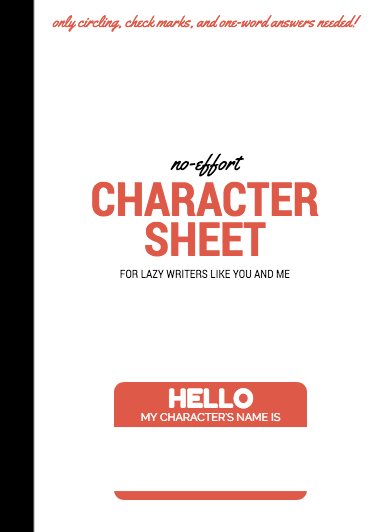

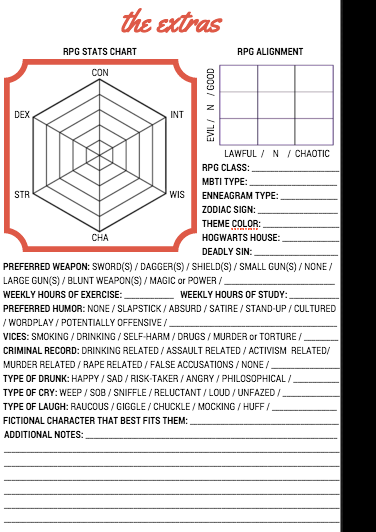
From the makers of the no-effort character checklist, I bring to you… The no-effort complete character sheet for lazy writers like you and me™!
Because the extra effort I put in staying up until 3 am to do put this together can save us all a lot of effort filling out longer character sheets ^^
You’re supposed to print it out and fold it in half to make a little booklet but you can save ink and do it on your computer :P
Link to PDF on google drive (fixed typo)
90K notes
·
View notes
Text

Writing with Color: Description Guide - Words for Skin Tone
We discussed the issues describing People of Color by means of food in Part I of this guide, which brought rise to even more questions, mostly along the lines of “So, if food’s not an option, what can I use?” Well, I was just getting to that!
This final portion focuses on describing skin tone, with photo and passage examples provided throughout. I hope to cover everything from the use of straight-forward description to the more creatively-inclined, keeping in mind the questions we’ve received on this topic.
So let’s get to it.
S T A N D A R D D E S C R I P T I O N
B a s i c C o l o r s

Pictured above: Black, Brown, Beige, White, Pink.
“She had brown skin.”
This is a perfectly fine description that, while not providing the most detail, works well and will never become cliché.
Describing characters’ skin as simply brown or beige works on its own, though it’s not particularly telling just from the range in brown alone.
C o m p l e x C o l o r s
These are more rarely used words that actually “mean” their color. Some of these have multiple meanings, so you’ll want to look into those to determine what other associations a word might have.

Pictured above: Umber, Sepia, Ochre, Russet, Terra-cotta, Gold, Tawny, Taupe, Khaki, Fawn.
Complex colors work well alone, though often pair well with a basic color in regards to narrowing down shade/tone.
For example: Golden brown, russet brown, tawny beige…
As some of these are on the “rare” side, sliding in a definition of the word within the sentence itself may help readers who are unfamiliar with the term visualize the color without seeking a dictionary.
“He was tall and slim, his skin a russet, reddish-brown.”
Comparisons to familiar colors or visuals are also helpful:
“His skin was an ochre color, much like the mellow-brown light that bathed the forest.”
M o d i f i e r s
Modifiers, often adjectives, make partial changes to a word.The following words are descriptors in reference to skin tone.
D a r k - D e e p - R i c h - C o o l
W a r m - M e d i u m - T a n
F a i r - L i g h t - P a l e
Rich Black, Dark brown, Warm beige, Pale pink…
If you’re looking to get more specific than “brown,” modifiers narrow down shade further.
Keep in mind that these modifiers are not exactly colors.
As an already brown-skinned person, I get tan from a lot of sun and resultingly become a darker, deeper brown. I turn a pale, more yellow-brown in the winter.
While best used in combination with a color, I suppose words like “tan” “fair” and “light” do work alone; just note that tan is less likely to be taken for “naturally tan” and much more likely a tanned White person.
Calling someone “dark” as description on its own is offensive to some and also ambiguous. (See: Describing Skin as Dark)
U n d e r t o n e s
Undertones are the colors beneath the skin, seeing as skin isn’t just one even color but has more subdued tones within the dominating palette.

Mentioning the undertones within a character’s skin is an even more precise way to denote skin tone.
As shown, there’s a difference between say, brown skin with warm orange-red undertones (Kelly Rowland) and brown skin with cool, jewel undertones (Rutina Wesley).
“A dazzling smile revealed the bronze glow at her cheeks.”
“He always looked as if he’d ran a mile, a constant tinge of pink under his tawny skin.”
Standard Description Passage
“Farah’s skin, always fawn, had burned and freckled under the summer’s sun. Even at the cusp of autumn, an uneven tan clung to her skin like burrs. So unlike the smooth, red-brown ochre of her mother, which the sun had richened to a blessing.”
-From my story “Where Summer Ends” featured in Strange Little Girls
Here the state of skin also gives insight on character.
Note my use of “fawn” in regards to multiple meaning and association. While fawn is a color, it’s also a small, timid deer, which describes this very traumatized character of mine perfectly.
Though I use standard descriptions of skin tone more in my writing, at the same time I’m no stranger to creative descriptions, and do enjoy the occasional artsy detail of a character.
C R E A T I V E D E S C R I P T I O N
Whether compared to night-cast rivers or day’s first light…I actually enjoy seeing Characters of Colors dressed in artful detail.
I’ve read loads of descriptions in my day of white characters and their “smooth rose-tinged ivory skin”, while the PoC, if there, are reduced to something from a candy bowl or a Starbucks drink, so to actually read of PoC described in lavish detail can be somewhat of a treat.
Still, be mindful when you get creative with your character descriptions. Too many frills can become purple-prose-like, so do what feels right for your writing when and where. Not every character or scene warrants a creative description, either. Especially if they’re not even a secondary character.
Using a combination of color descriptions from standard to creative is probably a better method than straight creative. But again, do what’s good for your tale.
N A T U R AL S E T T I N G S - S K Y

Pictured above: Harvest Moon -Twilight, Fall/Autumn Leaves, Clay, Desert/Sahara, Sunlight - Sunrise - Sunset - Afterglow - Dawn- Day- Daybreak, Field - Prairie - Wheat, Mountain/Cliff, Beach/Sand/Straw/Hay.
Now before you run off to compare your heroine’s skin to the harvest moon or a cliff side, think about the associations to your words.
When I think cliff, I think of jagged, perilous, rough. I hear sand and picture grainy, yet smooth. Calm. mellow.
So consider your character and what you see fit to compare them to.
Also consider whose perspective you’re describing them from. Someone describing a person they revere or admire may have a more pleasant, loftier description than someone who can’t stand the person.
“Her face was like the fire-gold glow of dawn, lifting my gaze, drawing me in.”
“She had a sandy complexion, smooth and tawny.”
Even creative descriptions tend to draw help from your standard words.
F L O W E R S

Pictured above: Calla lilies, Western Coneflower, Hazel Fay, Hibiscus, Freesia, Rose
It was a bit difficult to find flowers to my liking that didn’t have a 20 character name or wasn’t called something like “chocolate silk” so these are the finalists.
You’ll definitely want to avoid purple-prose here.
Also be aware of flowers that most might’ve never heard of. Roses are easy, as most know the look and coloring(s) of this plant. But Western coneflowers? Calla lilies? Maybe not so much.
“He entered the cottage in a huff, cheeks a blushing brown like the flowers Nana planted right under my window. Hazel Fay she called them, was it?”
A S S O R T E D P L A N T S & N A T U R E

Pictured above: Cattails, Seashell, Driftwood, Pinecone, Acorn, Amber
These ones are kinda odd. Perhaps because I’ve never seen these in comparison to skin tone, With the exception of amber.
At least they’re common enough that most may have an idea what you’re talking about at the mention of “pinecone."
I suggest reading out your sentences aloud to get a better feel of how it’ll sounds.
"Auburn hair swept past pointed ears, set around a face like an acorn both in shape and shade.”
I pictured some tree-dwelling being or person from a fantasy world in this example, which makes the comparison more appropriate.
I don’t suggest using a comparison just “cuz you can” but actually being thoughtful about what you’re comparing your character to and how it applies to your character and/or setting.
W O O D

Pictured above: Mahogany, Walnut, Chestnut, Golden Oak, Ash
Wood can be an iffy description for skin tone. Not only due to several of them having “foody” terminology within their names, but again, associations.
Some people would prefer not to compare/be compared to wood at all, so get opinions, try it aloud, and make sure it’s appropriate to the character if you do use it.
“The old warlock’s skin was a deep shade of mahogany, his stare serious and firm as it held mine.”
M E T A L S

Pictured above: Platinum, Copper, Brass, Gold, Bronze
Copper skin, brass-colored skin, golden skin…
I’ve even heard variations of these used before by comparison to an object of the same properties/coloring, such as penny for copper.
These also work well with modifiers.
“The dress of fine white silks popped against the deep bronze of her skin.”
G E M S T O N E S - M I N E R A LS

Pictured above: Onyx, Obsidian, Sard, Topaz, Carnelian, Smoky Quartz, Rutile, Pyrite, Citrine, Gypsum
These are trickier to use. As with some complex colors, the writer will have to get us to understand what most of these look like.
If you use these, or any more rare description, consider if it actually “fits” the book or scene.
Even if you’re able to get us to picture what “rutile” looks like, why are you using this description as opposed to something else? Have that answer for yourself.
“His skin reminded her of the topaz ring her father wore at his finger, a gleaming stone of brown, mellow facades.”
P H Y S I C A L D E S C R I P T I ON
Physical character description can be more than skin tone.
Show us hair, eyes, noses, mouth, hands…body posture, body shape, skin texture… though not necessarily all of those nor at once.
Describing features also helps indicate race, especially if your character has some traits common within the race they are, such as afro hair to a Black character.
How comprehensive you decide to get is up to you. I wouldn’t overdo it and get specific to every mole and birthmark. Noting defining characteristics is good, though, like slightly spaced front teeth, curls that stay flopping in their face, hands freckled with sunspots…
G E N E R A L T I P S
Indicate Race Early: I suggest indicators of race be made at the earliest convenience within the writing, with more hints threaded throughout here and there.
Get Creative On Your Own: Obviously, I couldn’t cover every proper color or comparison in which has been “approved” to use for your characters’ skin color, so it’s up to you to use discretion when seeking other ways and shades to describe skin tone.
Skin Color May Not Be Enough: Describing skin tone isn’t always enough to indicate someone’s ethnicity. As timeless cases with readers equating brown to “dark white” or something, more indicators of race may be needed.
Describe White characters and PoC Alike: You should describe the race and/or skin tone of your white characters just as you do your Characters of Color. If you don’t, you risk implying that White is the default human being and PoC are the “Other”).
PSA: Don’t use “Colored.” Based on some asks we’ve received using this word, I’d like to say that unless you or your character is a racist grandmama from the 1960s, do not call People of Color “colored” please.
Not Sure Where to Start? You really can’t go wrong using basic colors for your skin descriptions. It’s actually what many people prefer and works best for most writing. Personally, I tend to describe my characters using a combo of basic colors + modifiers, with mentions of undertones at times. I do like to veer into more creative descriptions on occasion.
Want some alternatives to “skin” or “skin color”? Try: Appearance, blend, blush, cast, coloring, complexion, flush, glow, hue, overtone, palette, pigmentation, rinse, shade, sheen, spectrum, tinge, tint, tone, undertone, value, wash.
Skin Tone Resources
List of Color Names
The Color Thesaurus
Things that are Brown (blog)
Skin Undertone & Color Matching
Tips and Words on Describing Skin
Photos: Undertones Described (Modifiers included)
Online Thesaurus (try colors, such as “red” & “brown”)
Don’t Call me Pastries: Creative Skin Tones w/ pics 3 2 1
Writing & Description Guides
WWC Featured Description Posts
WWC Guide: Words to Describe Hair
Writing with Color: Description & Skin Color Tags
7 Offensive Mistakes Well-intentioned Writers Make
I tried to be as comprehensive as possible with this guide, but if you have a question regarding describing skin color that hasn’t been answered within part I or II of this guide, or have more questions after reading this post, feel free to ask!
~ Mod Colette
170K notes
·
View notes
